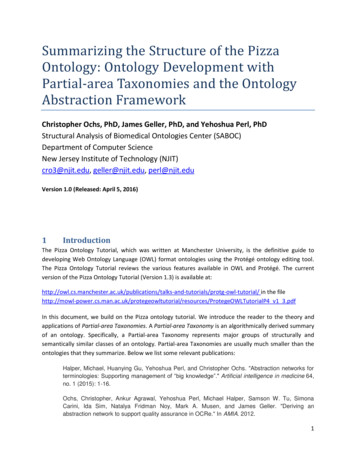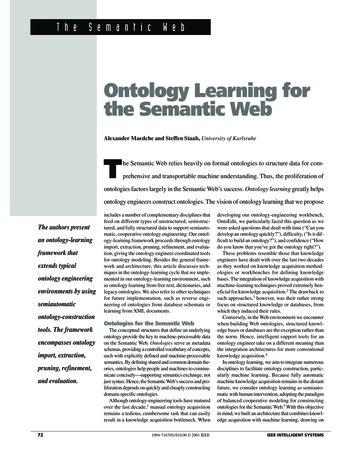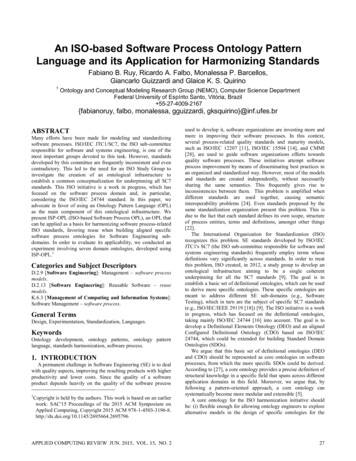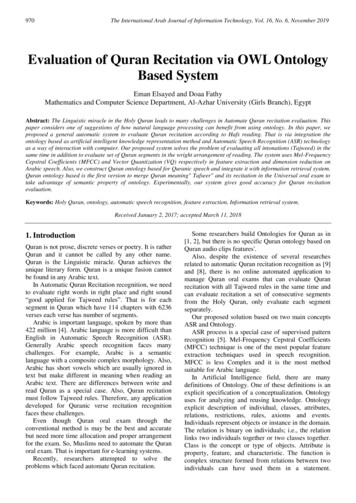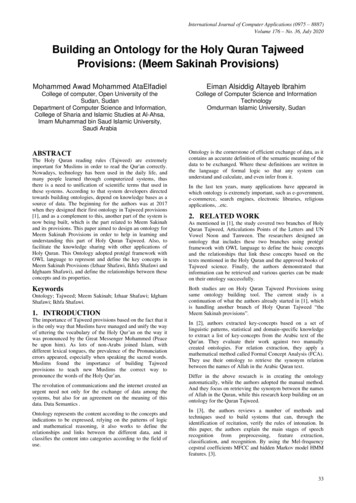
Transcription
International Journal of Computer Applications (0975 – 8887)Volume 176 – No. 36, July 2020Building an Ontology for the Holy Quran TajweedProvisions: (Meem Sakinah Provisions)Mohammed Awad Mohammed AtaElfadielEiman Alsiddig Altayeb IbrahimCollege of computer, Open University of theSudan, SudanDepartment of Computer Science and Information,College of Sharia and Islamic Studies at Al-Ahsa,Imam Muhammad bin Saud Islamic University,Saudi ArabiaCollege of Computer Science and InformationTechnologyOmdurman Islamic University, SudanABSTRACTThe Holy Quran reading rules (Tajweed) are extremelyimportant for Muslims in order to read the Qur'an correctly.Nowadays, technology has been used in the daily life, andmany people learned through computerized systems, thusthere is a need to unification of scientific terms that used inthese systems. According to that system developers directedtowards building ontologies, depend on knowledge bases as asource of data. The beginning for the authors was at 2017when they designed their first ontology in Tajweed provisions[1], and as a complement to this, another part of the system isnow being built, which is the part related to Meem Sakinahand its provisions. This paper aimed to design an ontology forMeem Sakinah Provisions in order to help in learning andunderstanding this part of Holy Quran Tajweed. Also, tofacilitate the knowledge sharing with other applications ofHoly Quran. This Ontology adopted protégé framework withOWL language to represent and define the key concepts inMeem Sakinah Provisions (Izhaar Shafawi, Ikhfa Shafawi andIdghaam Shafawi), and define the relationships between theseconcepts and its properties.KeywordsOntology; Tajweed; Meem Sakinah; Izhaar Shafawi; IdghamShafawi; Ikhfa Shafawi.1. INTRODUCTIONThe importance of Tajweed provisions based on the fact that itis the only way that Muslims have managed and unify the wayof uttering the vocabulary of the Holy Qur’an on the way itwas pronounced by the Great Messenger Mohammed (Peacebe upon him). As lots of non-Arabs joined Islam, withdifferent lexical tongues, the prevalence of the Pronunciationerrors appeared, especially when speaking the sacred words.Muslims found the importance of building Tajweedprovisions to teach new Muslims the correct way topronounce the words of the Holy Qur’an.The revolution of communications and the internet created anurgent need not only for the exchange of data among thesystems, but also for an agreement on the meaning of thisdata. Data Semantics .Ontology represents the content according to the concepts andindications to be expressed, relying on the patterns of logicand mathematical reasoning, it also works to define therelationships and links between the different data, and itclassifies the content into categories according to the field ofuse.Ontology is the cornerstone of efficient exchange of data, as itcontains an accurate definition of the semantic meaning of thedata to be exchanged. Where these definitions are written inthe language of formal logic so that any system canunderstand and calculate, and even infer from it.In the last ten years, many applications have appeared inwhich ontology is extremely important, such as e-government,e-commerce, search engines, electronic libraries, religiousapplications, .etc.2. RELATED WORKAs mentioned in [1], the study covered two branches of HolyQuran Tajweed, Articulations Points of the Letters and UNVowel Noon and Tanween. The researchers designed anontology that includes these two branches using protégéframework with OWL language to define the basic conceptsand the relationships that link these concepts based on thetexts mentioned in the Holy Quran and the approved books ofTajweed science. Finally, the authors demonstrated thatinformation can be retrieved and various queries can be madeon their ontology successfully.Both studies are on Holy Quran Tajweed Provisions usingsame ontology building tool. The current study is acontinuation of what the authors already started in [1], whichis handling another branch of Holy Quran Tajweed “theMeem Sakinah provisions”.In [2], authors extracted key-concepts based on a set oflinguistic patterns, statistical and domain-specific knowledgeto extract a list of key-concepts from the Arabic text of theQur'an. They evaluate their work against two manuallycreated ontologies. For relation extraction, they apply amathematical method called Formal Concept Analysis (FCA).They use their ontology to retrieve the synonym relationbetween the names of Allah in the Arabic Quran text.Differ in the above research is in creating the ontologyautomatically, while the authors adopted the manual method.And they focus on retrieving the synonym between the namesof Allah in the Quran, while this research keep building on anontology for the Quran Tajweed.In [3], the authors reviews a number of methods andtechniques used to build systems that can, through theidentification of recitation, verify the rules of intonation. Inthis paper, the authors explain the main stages of speechrecognition from preprocessing, feature extraction,classification, and recognition. By using the Mel-frequencycepstral coefficients MFCC and hidden Markov model HMMfeatures. [3].33
International Journal of Computer Applications (0975 – 8887)Volume 176 – No. 36, July 2020Both studies are compatible in the public domain “Tajweedsystems”. Whereas, the current research seeks to normalizeTajweed terminology through building a general knowledgebase that can be used for Tajweed applications.two letters will be combined into one Meem Mushaddah ( ) ّم ,and read with Ghunna (nasalization).3. BACKGROUNDBefore starting building this ontology, a number of importantterms must be defined, include:3.1 OntologyThe formal representation of a set of concepts within the fieldand the relationships between these concepts.3.2 TajweedIn language means optimization; and idiomatically meanstaking each letter out of its director with giving it its right andits due. The right of the letter is his self-qualities that arenecessary for it and which are inextricable from it, and its duemeans its pathological qualities, such as intoxication, arisefrom superiority, and like success, it arises from thewickedness. [4]Its provision: knowing about it is an obligation of sufficiency,and working with it is an obligation imposed on every Muslimreader for the Almighty saying : ( and chant the Quranrhythmically) [5]. And the words of the Messenger of Allah“Mohammed ﷺ :(Read the Qur’an with the melodies of theArabs, its voices, and beware of the people of immorality andmajor sins ). The subject of Tajweed is the Quranic word;and it is one of the noblest and best sciences, for hisattachment to the most honorable and dignified book.Fig 2: Examples of Al-Idghaam Al-Mithlayn [8]3.3.3 Al-Izhaar Al-ShafawiWhen any of the remaining 26 letters of the Arabic languageappears after the Meem Sakinah ( ) ْم , there will be IzhaarShafawi, with no Ghunna.3.3 Meem SakinahMeem Sakinah is the vowel-free Meem ( ) ْم , and that itsstability is fixed in the connecting and stopping. Whether itoccurs in a verb, in a name, or in a letter, medium or at theend. Since Meem sakinah is an oral letter that comes out withthe occlusion of the lips, all its rulings are oral. [6]There are three main rules regarding the Meem Saakin: [7] Ikhfa Shafawi. Idghaam Shafawi. Izhaar Shafawi.3.3.1 Al-Ikhfa Al-ShafawiThe rule will be Ikhfa Shafawi if the letter Baa ( )ب appearsafter the letter Meem Sakinah. it's a light nasal pronouncedsound, for two seconds (called two harakah).Fig 3: Examples of Izhaar (As-Shafawi) [8]4. PRACTICAL STUDYTo build any ontology there are several steps to be followedas shown in fig (4). [9]4.1 Determine ontology domainIn this paper the domain will be Quran Tajweed Provisions,and authors will focus on “Meem Sakinah Provisions”.Fig 1: Examples of Ikhfa (Al-Shafawi) [8]3.3.2 Al-Idghaam Al-ShafawiThe rule will be Idghaam Shafawi if the letter Meem ( )appears after the letter Meem Sakinah. It can be said that the34
International Journal of Computer Applications (0975 – 8887)Volume 176 – No. 36, July 2020 Clear is a property for all letters belong to classIzhaar Shafawi (all Arabic letters except Meemand Baa). Light lips touch is a property for the letter Baawhich belong to class Ikhfa Shafawi. Lips closing (ghunaa) is a property for the letterMeem Mushdadah which belong to class IdghaamShafawi.Fig 4: General steps for building ontology4.2 Define Meem sakinah provisions maintermsIn Meem sakinah provisions, the common terms include:Ikhfa Shafawi, Idghaam Al-Mithlayn, Izhaar Shafawi,Idghaam Shafawi, Makhaarij, Ghunna, nose, pronounce,character, letters, lips, Shafatain, light lips touch, lips closing,clear, Arabic letters, Baa, Meem, and harakah.4.3 Define the ontology classesFig 6: Object properties hierarchyAs in fig (7), there are data properties which linked classindividuals with data types, including: harakah: Integer data type with value 2 (2 counts,the duration of pronouncing Meem Mushdadahletter, which named ghunna). character: Literal data type, defining how the letterwill be written.The main class Thing shown in fig (5) consist of two classes: Makhaarij (letters outlets) with itssubclasses:oLips (Shafatain)oNose. letters: String data type, defining the letters belongto each class.Meem sakinah rules, with its subclasses:oIkhfa Shafawi.oIzhaar Shafawi.oIdghaam Shafawi (Idghaam AlMithlayn).Fig 7: Data properties hierarchy4.5 Define class properties of propertiesAt this stage, some constraints of class properties are defined,such as domain range constraint, cardinality constraint, anddata type constraint, fig (8, 9 and 10) consequently.For example, when the letter belongs to classIdghaam Shafawi is pronounced -letter Meem- the readershould close his lips (fig 8) for exactly two counts “twoharakah”, fig 10).Fig 5: Class hierarchy4.4 Define class propertiesAll these classes have properties that linked between itsindividuals which called object properties. As shown in fig(6), the object property pronounce include several subproperties according to the Meem Sakinah rule subclasses, asfollows:35
International Journal of Computer Applications (0975 – 8887)Volume 176 – No. 36, July 2020Fig 8: lips closing constraintFig 10: Cardinality constraint4.6 Define the instancesAs shown in fig (11), ontology populate with instances of allontology classes. letter meem is an instance for class IdghamShafawi, with more details for letter meem shownin fig (12). letter baa is an instance for class Ikhfa Shafawi, all arabic letters except Meem and Baainstance for class Izhaar Shafawi.isanFig 9: clear constraintFig 11: Classes instancesFig 12: letter meem instance with more details36
International Journal of Computer Applications (0975 – 8887)Volume 176 – No. 36, July 20205. RESULT AND DISCUSSIONAfter completing the ontology construction, and ensure thatall its classes are consistent with each other via the Reasoner,now it is possible to inquire about its components (classes,subclasses, properties, etc.) using SPARQL or DLquery. Theinquire can be done either for all ontology components, asshown in fig (13), or for a specific component using wherecondition part.SELECT ?subject ?objectWHERE { ?subject rdfs:subClassOf ?object }Above SPQRQL Query will retains back all ontologysubjects and objects.Fig 13: Full ontology query result using SPQRQLFig 14 and 15 show a query done using DLquery, which showdetails of class Izhaar Shafawi and Idgham Shafawiconsequently. These details can be controlled through theright side check points.Fig 14: Izhaar Shafawi query using DLquery37
International Journal of Computer Applications (0975 – 8887)Volume 176 – No. 36, July 2020Fig 15: Idgham Shafawi query using DLquery6. CONCLUSION[4] 1972 , المكتبت الثقافيت : بيروث , البرهان في تجويد القرآن , قمحاوي . ا . .Via using Protégé framework with OWL language, anontology for Meem Sakinah provisions is constructed. Firstly,the main terms are listed, then using the concepts of classesand subclasses in programming, these concepts and therelations between them are identified. On the other hand, andaccording to Meem Sakinah rules, some constraints are put onsome properties. Finally, instances are attached for each class,while the Reasoner is used to check class consistency.Eventually, SPARQL and DL Query are used to inquire aboutMeem Sakinah ontology components.[5] Allah, The Holy Quran.7. REFERENCES[6] 1994 , القاهرة , غايت المريد في علم التجويد , نصر . ق . ع .[7] m-saakin. [Accessed 20 May 2020].[8] "AT-TAJWEED 4 BEGINNERS," 27 August s.wordpress.com/the-rules-ofmeem-as-sakinah-2/. [Accessed 21 May 2020].[1] E. A. M. A. E. Ibrahim, "Provisions of Quran TajweedOntology (Articulations Points of the Letters, UN VowelNoon and Tanween)," International Journal of Scienceand Research, vol. 6, 2017.[9] M. A. M. A. Eiman Alsiddig Altayeb Ibrahim, "OntologyLife Cycle: A survey on the Ontology and itsDevelopment Steps," International Journal of science andresearch, vol. 6, no. 8, 2017.[2] E. A. Sameer M. Alrehaili, "Unsupervised method forOntology Learning from the Quran," in the 9th saudistudents conference, Birmingham, 2016.[10] "Tajweed In English And Creole Lesson 5 Rules OfMeem," Islam Iman Ihsan, [Online]. Available:https://www.youtube.com/watch?v ymQ LJa2H34.[Accessed 21 May 2020].[3] A. M. Z. Mohamed A. Mahmod, "AUTOMATEDQURANIC TAJWEED CHECKING RULES SYSTEMTHROUGH RECITATION RECOGNITION: AREVIEW," in 4 th International Conference On IslamicApplications in Computer Science and Technology,Sudan, 2016.IJCATM : www.ijcaonline.org[11] S. F. M. Tawil, "Application of OASys approaches fordates ontology," 2009.38
Both studies are on Holy Quran Tajweed Provisions using same ontology building tool. The current study is a continuation of what the authors already started in [1], which is handling another branch of Holy Quran Tajweed "the Meem Sakinah provisions". In [2], authors extracted key-concepts based on a set of

